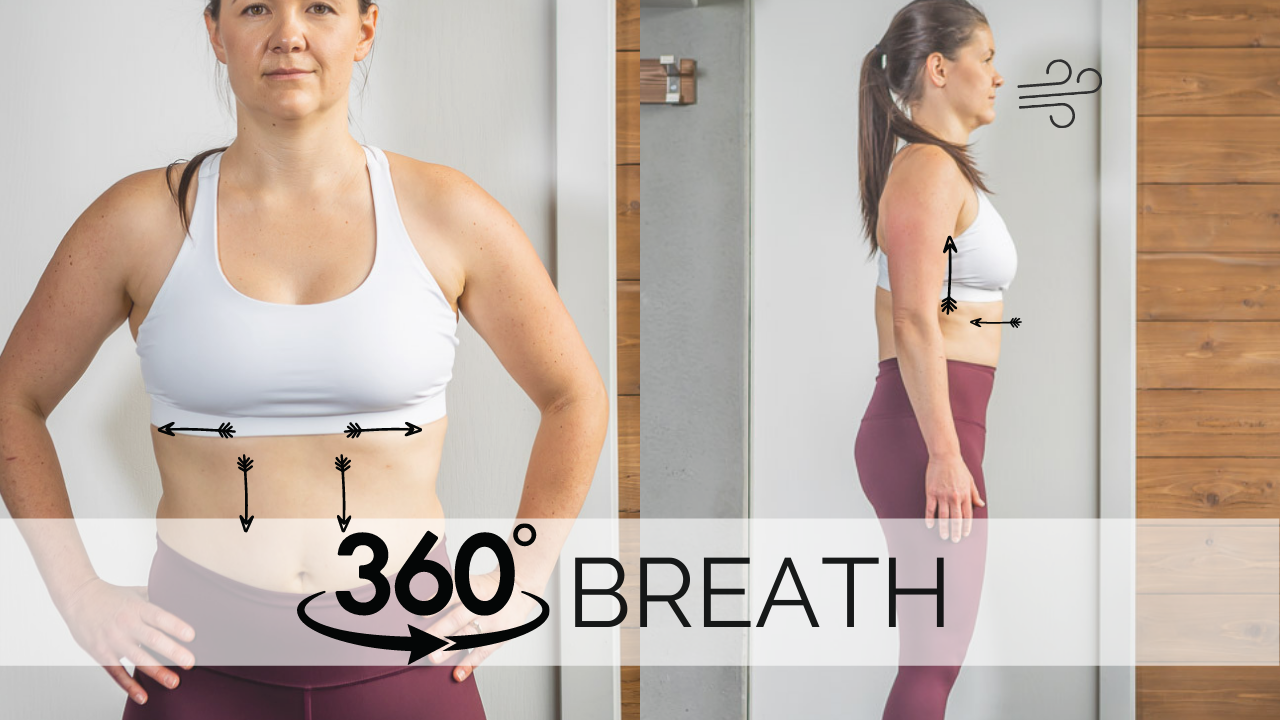360 / Diaphragmatic Breathing
Feb 06, 2021
Where your air goes matters!!!
When you inhale the diaphragm should actively draw down, decreasing pressure above creating a vacuum so the lungs can fill with air and also increasing pressure below expanding the abdominal and pelvic floor.
If you breath all into your chest your diaphragm doesn’t do the work it should and your pelvic floor is unable to relax.
We need the pelvic floor to fully relax for max contraction of the pelvic floor, which then triggers the TVA /deep abdominal muscles to contract. This creates stability in the core!
When you exhale the diaphragm should ascend, the pelvic floor and the transverse abdominis gently contract.
During a pregnancy a dysfunctional shallow breathing pattern normally occurs because the baby took up space in your belly and ribs which forced the air to stay up in your chest and shoulders.
So postpartum we need to fix this...
Lets work on the 360 breath now!
Inhale: try with your hands in these different positions
▫️Place hands on your low belly inhale and feel your belly expand
▫️Place your fingers on your ribs with your thumbs pointing towards your back, feel the ribs expand like an umbrella opening up.
▫️Place your hands on your low back and feel the lower ribs expand in to your hands.
As you inhale feel the pelvic floor relax, like you are slowly letting go of a blue berry you just picked up with your vagina, don't just let it drop out.
You may find this very difficult to do. However, taking time to practise deep breaths on the inhale can help mobilize the ribs and over time as they become more supple they will be able to expand more easily.
Are you compensating?
▫️Are you breathing too much into your chest, shoulders?
▫️Is your back arching when you breath in?
▫️Are you only breathing into your belly?
▫️Are you only breathing into your chest?
Exhale: try with your hands in these different positions
1. Hands on low belly exhale and gently think about drawing your fingers closer together with your muscles and breath only, continue to lift upwards towards the front of your pubic bone lifting the pelvic floor.
2. Hands on either side of your belly button: slowly exhale, imagining your abs traveling toward the centre/midline.
3. Hands on ribs: exhale and draw your ribs together, feel them close and slightly draw down.
Exhale fully, there should be no air left in the lungs. This should feel like WORK
As the PF contracts and lifts this will trigger the TVA to engage. The TVA is like a corset, you can help this engagement further by picturing the corset tightening around your waist, then think about your ribs coming in and down.
Are you compensating?
▫️Can you do all this with out tensing your butt?
▫️Is your belly protruding/ coning outward?
▫️Are your shoulders lifting?
▫️Are you tilting your pelvis excessivly?
When done right a 360 /dyaphramatic breath will facilitate automatic function of the core. We don’t want to have to think about activating our core with our every move!

However, breath can and should complement and match the demand of the movement. The more forcefully you exhale the more the core engages and create support. So if you are lifting something heavy, your exhale should be more forceful.
Happy Breathing, just a couple minutes a day can make a big difference.

Lorem ipsum dolor sit amet, consectetur adipiscing elit. Cras sed sapien quam. Sed dapibus est id enim facilisis, at posuere turpis adipiscing. Quisque sit amet dui dui.
Stay connected with news and updates!
Join our mailing list to receive the latest news and updates from our team.
Don't worry, your information will not be shared.
We hate SPAM. We will never sell your information, for any reason.

